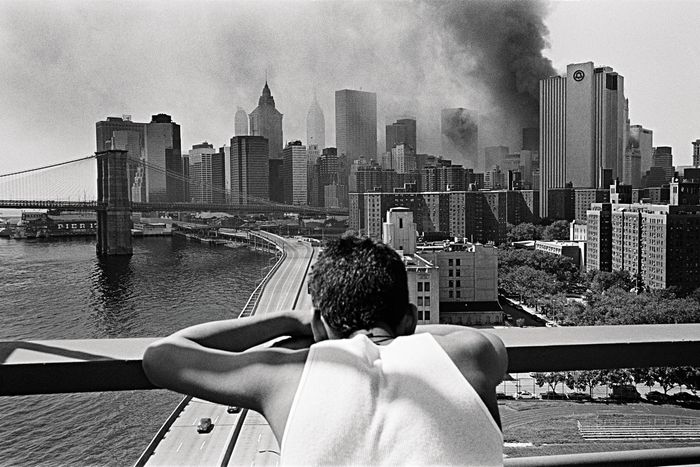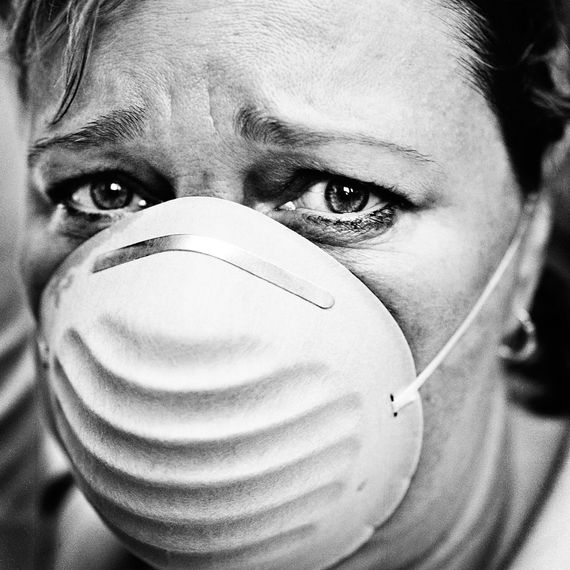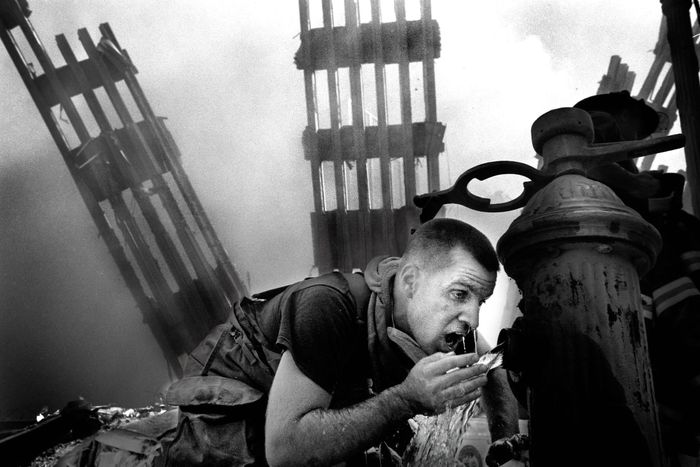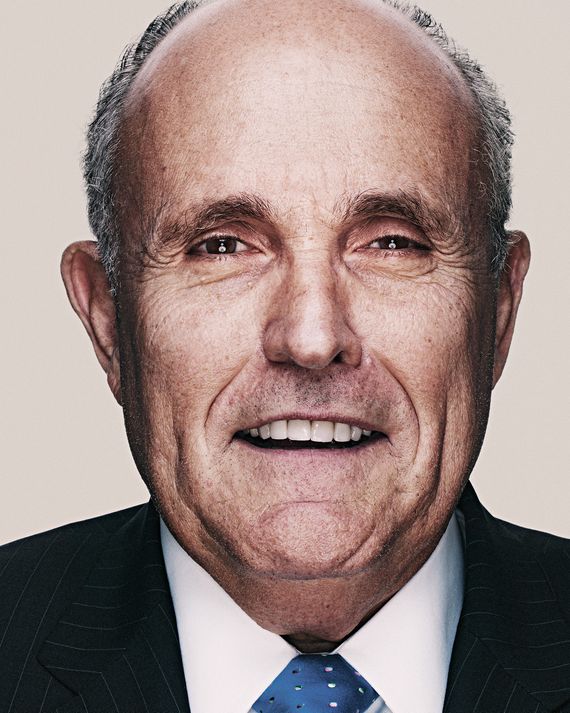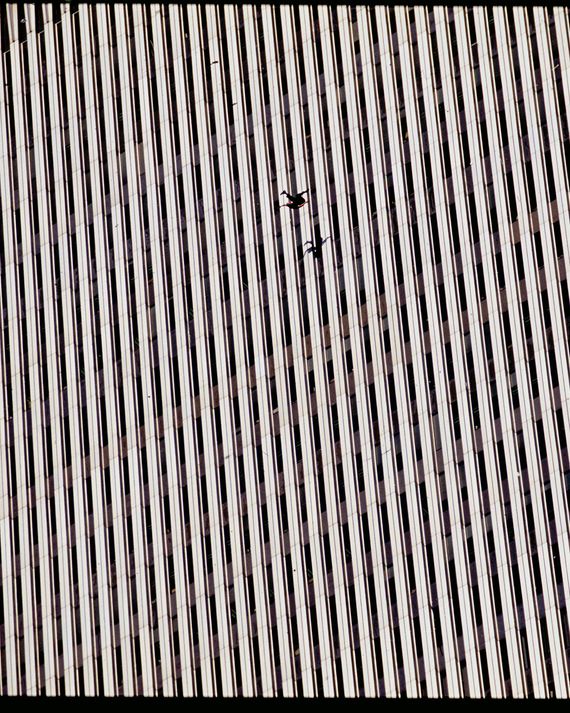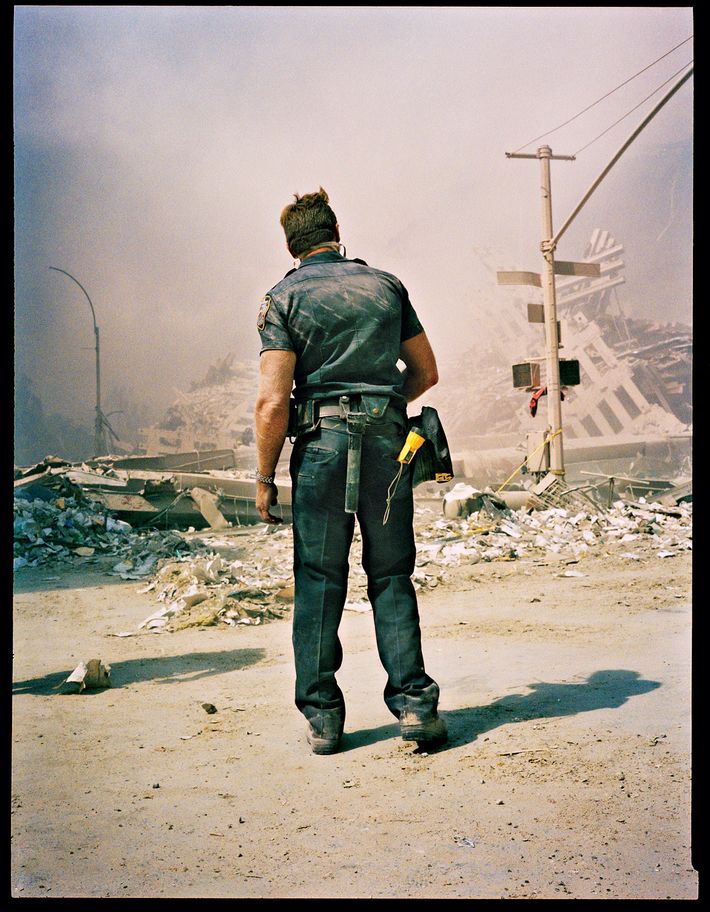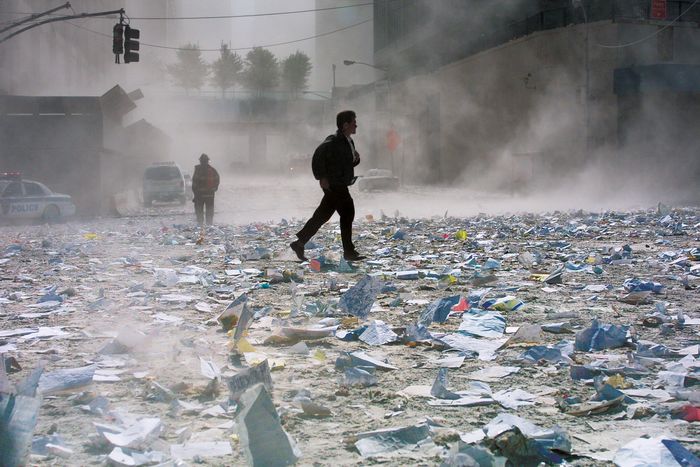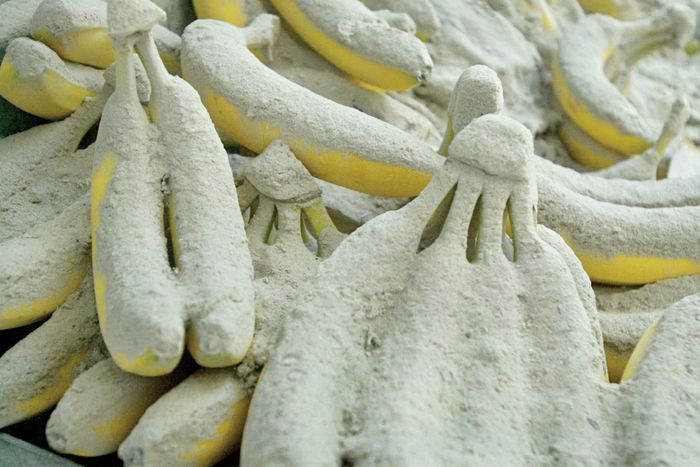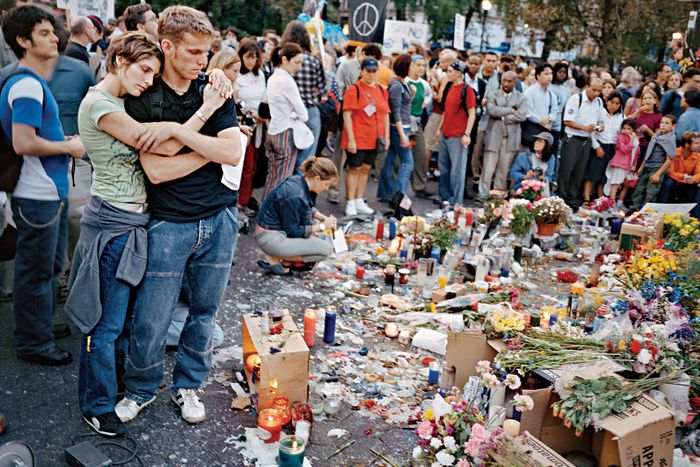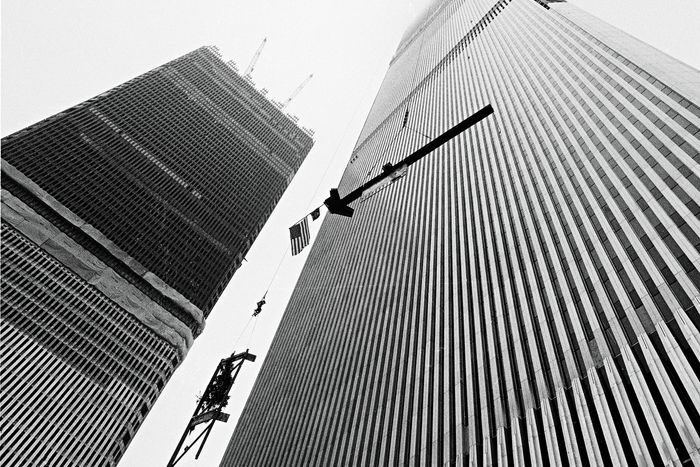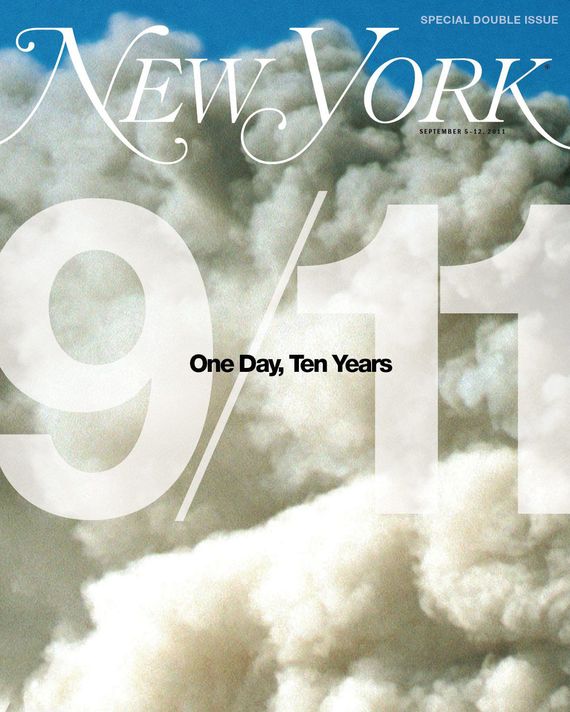
This special issue of New York Magazine was originally published on September 5, 2011.
Here in New York City, we heard it first, the drone of the plane down the West Side, surprisingly loud. Then, if we were outside, our heads pointed in the right direction, we could see it: the dull-red gash in the North Tower, smoking ominously. Just as we’d begun to absorb this strange sight, wondering what pilot could have been so dim as to steer his plane into one of those towers on what seemed the clearest, bluest September day anyone could remember, came a second plane, then a terrible blossom of flame, then the billowing smoke enshrouding downtown. There would be more, of course, two planes aimed at Washington, one that would dive into the Pentagon, the other downed in a field in Pennsylvania. But for New Yorkers, it was the most intimate of tragedies. Within weeks, the day had become a number, a kind of shorthand for a whole universe, one that hadn’t existed on 9/10.
Many of us here remember going to work that week, searching for an appropriate journalistic response to a world that was changing in ways we couldn’t yet see. As this anniversary loomed, we found ourselves asking the inverse of the same question: With all we now know, how to begin to address the enormity of the event? Our solution was not to shrink from its scale but to embrace it. We decided to reach back to an old form that might allow us to account for a wide assortment of what was created in the wake of the destruction: heroes and villains, great and awful ideas, twisted fates, pop songs and myths and wars. The alphabetized jumble of an encyclopedia, with its preposterous aspiration to describe whole cultures and continents and bodies of knowledge in a single place—that, we thought, might be an interesting way to take in the multiplicity of 9/11’s effects. So we asked our own writers, and a host of distinguished others, to explore a range of subjects that might in their aggregate add up to a kind of idiosyncratic assessment. Some of the resulting 92 entries we kept in the vernacular of a reference book; some we allowed to deviate to accommodate remembrances and other emotional responses. We sought imagery that either felt fresh to us or hauntingly familiar—we were looking throughout to balance sentiment with distance. Borrowing from the old musty volumes on hand, we ran illustrations and data and artifacts up the margins.
In spite of its form, our encyclopedia makes no claim to be comprehensive. It’s neither a first draft of history nor a verdict—just a set of impressions from some point in between. September 11, 2001, changed everything, or it did not; it will take a lot more than ten years to figure that out.
A
Abbottabad
Pastoral deathplace of a terrorist mastermind.
Airport Security
Where the new normal has become (almost) routine.
Al Qaeda
Post-Osama, now what?
“America”
An idea with many authors.
Anthrax
How terror created a rush to judgment.
Artifacts
The things left behind.
B
Blind Sheik
His American fatwa had terrible repercussions.
Blood
A touching, unnecessary sacrifice.
Bloomberg, Michael
The mayor’s tough, crucial attitude: Get over it.
Blue
What everyone would remember first.
Building 7, Collapse Of
The conspiracy-theorist’s favorite structure.
Bullhorn
What the president used to find his voice again.
Bush, George W.
Will history judge his presidency the way it did Truman’s?
C
Cantor Fitzgerald
The firm that lost the most.
Carpooling
Liz, Jacko, and Marlon: The starriest refugees in history.
Cheney, Dick
The other leader of the free world, 2001–2008.
Collected Works
How artists, writers, musicians, filmmakers, video-game designers, and quilters responded to the attacks—a selection.
Commander in Chief, Accidental
The brief, harrowing administration of Richard A. Clarke.
D
Dead, Accounting of the
From the dust, a numerology of loss.
Dragnets
A season of suspicion in Little Pakistan.
E
Election, Mayoral
How America’s Mayor created New York’s mayor.
Evidence
Secrets left in an airport parking lot.
F
Families, The
A potent coalition forms and fractures.
FDNY
Wrestling with the myths of martyrdom.
First Responses
A race to the scene, and then—chaos.
Flight Attendants
The heroes of the day weren’t all men.
Freedom Fries
What’s in a word? A culture war.
Frozen Zone, Life in the
Behind the fence, a kind of Utopia.
G
Gitmo
Despite the fast-food counters, Twilight Zone endures.
Giuliani, Rudy
Giving him his due.
Gold, Recovery of
The Towers’ buried treasure.
Good-Bye
A phone call from the 105th floor.
Green, Mark
The almost mayor.
Ground Zero
A label to rally around.
H
Highway Deaths
Forgoing flight, at peril.
Hijackers, The
Who were they?
Holding Out
The family for whom the truth is more important than the money.
Homeland Security
Big threats, bigger government.
Humor
Timing was everything.
I
Iraq
Hunting for a link.
Irony, The End of
Why Graydon Carter wasn’t entirely wrong.
Islam
A story of reformation.
J
Jumpers
Why the most haunting images of 2001 were hardly ever seen.
K
Kids
The kindergarten class of P.S. 150 remembers.
L
“Let’s Roll”
Catchphrase for a rattled country.
Libeskind, Daniel
The lessons of the master planner.
Live from New York
The return of Saturday Night Live.
Lynch, Michael
One name, three guys.
M
Memorial
Affecting remembrance or adornment for real estate? A review.
Missing-Persons Posters
Street art with awful power.
N
“Never Forget”
Memory, playing tricks.
New York
What we were before; what we are now.
9/11, Name of
We had to call it something.
NYPD
Looking for terrorists, the police look at everyone else.
O
P
Paper, Dispersal of
The odd sparkle of devastation.
Pataki, George
Ambition unrewarded.
Patriot Act
The kitchen-sink approach to national security.
Pentagon, The
The target the terrorists got right.
Philip, Sneha Anne
The most mysterious of the missing.
Planes, The
Flying weapons.
Portraitists of Grief
2,400 lives, each in 200 words or less.
Preemption
An idea whose time was made.
Q
Quiet
The dumbstruck city.
R
Republican Convention
When Bushworld came to town.
Rove, Karl
Choreographer of a war presidency.
Rumsfeld, Donald
The Pentagon poet found his rhythm, then lost it.
S
Satan’s Face
In the smoke, a sign.
Sex and the City
Was it still okay to drink cosmos?
Stairwell A
The only way out.
Stockhausen, Karlheinz
The unsettling question of the Sublime.
Surfing the Collapse
A Tony Hawk–meets–Tom Cruise fantasy, based partly on fact.
Survivor, Last Pulled Out
Only twenty escaped from the rubble.
T
Television News
The last days of intermediation.
Terror Sex
Love (or at least lust) in the ruins.
Tora Bora
Where the new way of war failed.
Torture
Once anathema, now a choice.
Toxic Dust
“The air quality is safe and acceptable.”
Total Progressive Collapse
Why, precisely, the towers fell.
Tribute in Light
The first memorial.
Twentieth Hijacker, The
Who else was supposed to join the attacks?
U
Unidentified Remains
The ongoing task of cataloguing hell.
V
Vigil
Union Square, the gathering place for public grieving.
W
Wall Street Journal, The
A long commute.
Wall Street West
The backup plan that wasn’t.
Widow, the Fake
The making of a perfect victim.
Windows on the World
It was never about the food.
X
Xenophobia
The politics of the mosque.
Y
Yamasaki, Minoru
An architect whose legacy didn’t work out as he’d planned.
Yankees, The
Baseball as therapy.
Z
Zazi, Najibullah
The face of terrorism to come?


